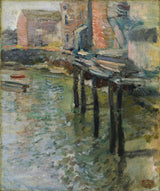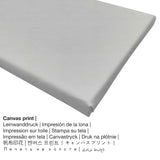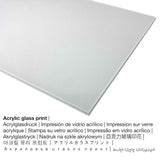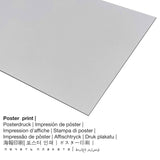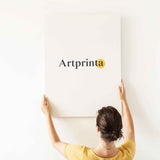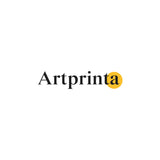John Henry Twachtman, 1902 - Deserted Wharf (The Old Mill na Cos Cob) - ọmarịcha akwụkwọ nka.
Ụtụ gụnyere. Mbupu gbakọrọ na ndenye ọpụpụ.
Ozi mgbakwunye sitere na webụsaịtị ihe ngosi nka (© - Ụlọ ihe ngosi nka nke Cleveland - Velọ ihe ngosi nka nke Cleveland)
In 1892, John Twachtman, one of the most imaginative of the American Impressionists, established a summer colony at Cos Cob, Connecticut. This painting depicts the Holley Mill near Cos Cob. Unlike the French Impressionists, who tended to analyze the effects of light and color in a scene, Twachtman was interested in expressing the pure poetry of color and his emotional response to the changes he observed in nature.
Tebụl a haziri ahazi nke mpempe nka
| Aha eserese: | "Deserted Wharf (The Old Mill at Cos Cob)" |
| Nhazi: | sere |
| Category: | nkà nke oge a |
| oge: | 20th narị afọ |
| Emepụtara n'afọ: | 1902 |
| Ogologo afọ nka nka: | 110 afọ |
| Usoro izizi: | mmanụ na kwaaji |
| Nha nke ihe osise izizi: | Emebereghị: 61,5 x 51 cm (24 3/16 x 20 1/16 na) |
| Ụlọ ihe ngosi nka: | Velọ ihe ngosi nka nke Cleveland |
| Ebe ngosi nka: | Cleveland, Ohio, United States nke America |
| website: | Velọ ihe ngosi nka nke Cleveland |
| Ụdị nka nka: | ngalaba ọha |
| Site n'aka: | Velọ ihe ngosi nka nke Cleveland |
| kreditline ọrụ nka: | Bequest of Julia Morgan Marlatt |
Onye na-ese ihe
| aha: | John Henry Twachtman |
| Aha ndị ọzọ: | john h. twachtman, Twachtman John Henry, twachtman john, j.h. twachtman, twachtman j.H., Twachtman, Twatchman John Henry, Twachtman John H., John Henry Twachtman, twachtmann john H., twachtman J.H. |
| Gender: | nwoke |
| Nationality: | American |
| Ọrụ onye na-ese ihe: | onye na-ese ihe |
| Country: | United States |
| nhazi ọkwa: | omenkà nke oge a |
| Ụdị nka: | Mmetụta |
| Afọ ọnwụ: | 49 afọ |
| Afọ ọmụmụ: | 1853 |
| Ebe omuma: | Cincinnati, Hamilton County, Ohio, Njikota Obodo Amerika |
| Nwuru: | 1902 |
| Nwụrụ na (ebe): | Gloucester, Essex County, Massachusetts, Njikota Obodo Amerika |
Nkọwa ihe ahaziri ahazi
| Nkewa ngwaahịa: | nka nka |
| Mmeputakwa: | mmeputakwa n'ụdị dijitalụ |
| Usoro mmepụta: | mbipụta dijitalụ (Mbipụta UV ozugbo) |
| Nlụpụta: | emere na Germany |
| Stockdị ngwaahịa: | mmepụta ihe na-achọ |
| Eji ngwaahịa a chọrọ: | ihe ndozi mgbidi, mkpokọta nka (mmeputakwa) |
| Nhazi onyonyo: | usoro eserese |
| Oke akụkụ: | 1: 1.2 |
| Nkọwa: | ogologo bụ 20% mkpụmkpụ karịa obosara |
| Akwa ngwaahịa dị: | akwụkwọ mmado (akwụkwọ kwaaji), mbipụta ọla (aluminium dibond), mbipụta iko acrylic (nke nwere ezigbo mkpuchi iko), mbipụta akwụkwọ. |
| Mbipụta kanvas (akwa akwa na etiti ihe ndọtị): | 50x60cm - 20x24", 100x120cm - 39x47" |
| Mpempe iko acrylic (nwere ezigbo mkpuchi iko) nha: | 50x60cm - 20x24", 100x120cm - 39x47" |
| Mpempe akwụkwọ mmado (akwụkwọ kwaaji) nha dị iche iche: | 50x60cm - 20x24", 100x120cm - 39x47" |
| Nha ebipụta aluminium dibond: | 50x60cm - 20x24", 100x120cm - 39x47" |
| Igwe onyonyo: | na-enweghị etiti |
Nye iwu ngwaahịa ị ga-achọ inwe
Na nhọrọ ndọpụta dị n'akụkụ onyinye ngwaahịa ị nwere ike họrọ ihe yana nha dabere na mmasị gị. Nhọrọ ndị a dị maka n'otu n'otu:
- Mbipụta kanvas: The canvas direct print is a printed cotton canvas stretched on a wood stretcher. The printed canvas produces a cosy, warm atmosphere. The advantage of canvas prints is that they are relatively low in weight. This means, it is easy and straightforward to hang up the Canvas print without any wall-mounts. Because of thata canvas print is suited for all kinds of walls.
- Aluminom dibond (ọkpụkpụ ọla): Aluminium Dibond prints are metal prints with an impressive effect of depth. For the Direct Aluminium Dibond print, we print the favorite work of art right on the aluminium white-primed surface. This UV print on aluminium is one of the most popular entry-level products and is an extremely sophisticated way to showcase fine art prints, as it puts 100% of the viewer’s focus on the whole artwork.
- Mbipụta akwụkwọ mmado (akwa akwa akwa): The Artprinta poster is a UV printed canvas paper with a slight surface finish. Please bear in mind, that depending on the size of the poster print we add a white margin of approximately 2-6cm round about the painting, which facilitates the framing.
- Mbipụta iko acrylic (nke nwere ezigbo mkpuchi iko): A glossy print on acrylic glass, which is often described as a print on plexiglass, will change an original artwork into gorgeous home decoration. With an acrylic glass art print contrasts and small artwork details become recognizeable with the help of the very subtle gradation.
Ozi zuru ezu gbasara akụkọ
The 20th narị afọ mpempe nka Deserted Wharf (The Old Mill at Cos Cob) onye na-ese ihe sere ya John Henry Twachtman n’afọ 1902. E ji nha-eme ihe nka. Emebereghị: 61,5 x 51 cm (24 3/16 x 20 1/16 na) e tekwara ya na ọkara mmanụ na kwaaji. Today, the piece of art belongs to the art collection of The Cleveland Museum of Art, which is one of the leading museums worldwide that builds, preserves, studies, and shares its outstanding collections of art from all periods and parts of the world, generating new scholarship and understanding, while serving as a social and intellectual hub for its community. With courtesy of Velọ ihe ngosi nka nke Cleveland (public domain license). The creditline of the artwork is: Bequest of Julia Morgan Marlatt. What is more, the alignment is in portrait format ma nwee oke nke 1: 1.2, nke pụtara na ogologo bụ 20% mkpụmkpụ karịa obosara. John Henry Twachtman was a painter, whose style can be classified as Impressionism. The Impressionist painter was born in 1853 in Cincinnati, Hamilton county, Ohio, United States and died at the age of 49 N'afọ 1902 na Gloucester, Essex County, Massachusetts, United States.
Nkwupụta iwu: We try our best in order to depict the art products as closely as possible and to illustrate them visually on the various product detail pages. At the same time, the tone of the print products and the imprint can diverge slightly from the presentation on your screen. Depending on your screen settings and the nature of the surface, not all color pigments are printed one hundret percent realistically. Considering that all the fine art prints are printed and processed manually, there may also be minor deviations in the motif's size and exact position.
© Nchekwa ikike nwebisiinka - www.artprinta.com (Artprinta)

